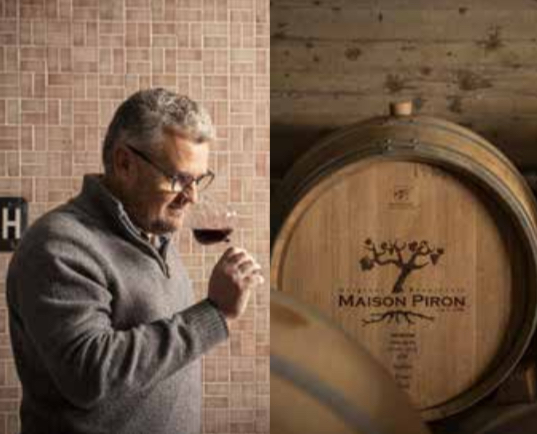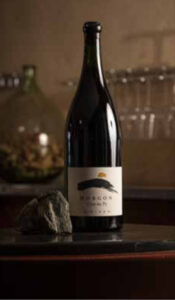FOUR CENTURIES OF RENEWED AND MASTERFUL PASSION

Rooted in a family of winegrowers spanning fourteen generations, the estate now embraces a modern and demanding vision of winemaking under the leadership of Julien Revillon, who took over from Dominique Piron in 2020. Working alongside oenologist Pierre Meunier and head vineyard manager Aurélien Jambon, Julien continues Piron’s legacy with dedication, enhancing the potential of Gamay and the most prestigious Beaujolais crus – such as Morgon, Fleurie, Moulin-à-Vent, Chénas and Brouilly – while also cultivating Chardonnay for the maison’s whites.
Today, between estate-owned vineyards and négoce activity, Maison Piron directly tends around 50 hectares using environmentally respectful methods and buy wines/juices from another 50 hectares (so, a total production of 100 hectares). The goal: to preserve the identity of each terroir and produce wines that are precise, authentic, and vibrant. From the most ambitious crus to the most enjoyable everyday wines, the range reflects a perfect balance of tradition, precision, and passion. The wines are now distributed in around 60 countries worldwide, supported by a network of 80 agents in France and several key accounts such as METRO, Monoprix, Lagardère, Waitrose, Wine Society, Coopérative U… Julien Revillon, supported by the talented oenologist Pierre Meunier, is carrying on Dominique Piron’s work with consistency and brilliance. Their efforts are bolstered by Thibaud Lemaître, head vineyard manager and a key figure in the stewardship of the estate’s 100 hectares. Thanks to the shared commitment of this trio, grape quality has significantly improved, and the process of parcel selection is now bearing tangible results. What stands out is the stylistic consistency of the wines, built on three pillars: natural fruit expression, drinkability, and a clear reflection of each cru’s identity. Heir to a long family tradition, Dominique Piron entrusted the estate to Julien Revillon in 2020, after working side by side with him since 2013. Today, the estate manages about 50 hectares, combining owned vineyards with carefully sourced grapes for négoce production.
Who is Maison Piron ?
The estate cultivates some Chardonnay, but is primarily focused on Gamay, the emblematic grape of Beaujolais. Specializing in the Morgon appellation and its climats – especially the famed Côte du Py, a volcanic hill iconic to the region – the Domaine also produces Beaujolais, Beaujolais-Villages, Régnié, Brouilly, Fleurie, Chénas, and Moulin-à-Vent in red, rosé, and white versions. The vineyard work follows traditional practices, alternating between ploughing and grassing down, with a strong emphasis on environmental sustainability and terroir enhancement.
Face to Face with Julien Revillon
VertdeVin: Why do you make wine ? What made you become a winemaker ?
Julien Revillon: That’s a good question. Because it wasn’t something natural in my family – I didn’t come from a family of winemakers. The passion came little by little. Around my house, vineyards were everywhere. In Beaujolais, wine culture is omnipresent. At school, I was the only one who wasn’t the son of a winemaker. But I immediately fell in love with the atmosphere: being in the winery, the smells of fermentation, the wines that start off sweet, and slowly refine with time. We’re a family of epicureans – my grandfather was a Michelin-starred chef – and there was always wine on the table. Gradually, my love for wine grew. I did wonder whether mixing passion and profession was a good idea. At first, I didn’t want to work directly in the wine world, but step by step, I found myself drawn to it. It’s true that the idea kept popping into my head – to be both the owner and involved in winemaking. I came into this hands-on, learned on the job, with the help of people who supported me – and still do. For me, winemaking is really a team effort. It’s never just one person in their corner; it’s an entire team, out there every day, with attention and sensitivity.
I’m very Cartesian, very scientific. What’s fascinating about winemaking is that even with a scientific mindset, you often can’t fully understand what’s happening. Determinism is one of the cornerstones of science: if you do the same experiment under the same conditions, you expect the same result. But in winemaking, that just doesn’t apply – conditions are never identical. So you’re always in doubt: will this decision be positive? Negative? And that makes it intellectually exciting.
VdeV: Can you tell us a bit about your range ? Is there a signature style to your wines – something that tells you “yes, this is good” ?
J.R.: Great question. It’s something I ask myself every day. The first thing I wanted to do when creating the range was to cover the full spectrum – from what some might call « basic » (though I wouldn’t use that word), to the top. Let’s say: from the left to the right. My core idea was to make truly great wines in Beaujolais – wines that could stand alongside the grands crus of other regions: Bordeaux, Rhône, Burgundy, or beyond. I see Gamay and the Beaujolais terroirs as a sort of universal Grand Cru archetype – unique and exemplary. But I also wanted to create fun, playful wines – more accessible, market-driven wines. That excites me too: working on blends, using our grape variety, our style, our terroirs.
Not every terroir can give you the same kind of wine. The winemaker learns from the land, and the biggest lesson is knowing what type of wine each terroir can offer. Some will always produce grand terroir wines; others are better suited for something simpler.
So yes, I wanted to build a full range – from easydrinking blends, assembled like a chef composes a salad, layering one element after another to create harmony – to single-terroir crus, where you want to preserve the uniqueness and individuality of the soil. And that’s incredibly exciting.
VdV: What has been your greatest tasting emotion ?
J.R: Another excellent question. I wouldn’t say I have a single greatest emotion—I’ve had many… but ultimately, very few. For me, having just one great emotion a year is already huge. I drink a lot of exceptional wines—Romanée-Conti, old Pomerols, grand Alsatian wines—but a true emotion ? Once a year, maybe. I’ll go back to the earliest one, the one that marked me the most. I was maybe 12, 13, 14 years old. My father opened a Crème de Tête from Château Gillette, vintage 1950—the year my mother was born. That wine completely opened my eyes to the world of great wines. It was something entirely different from the Gamay we drank regularly, even different from great Burgundies. So that was my first real wine emotion. And probably the one that pushed me to go further, to discover more.
